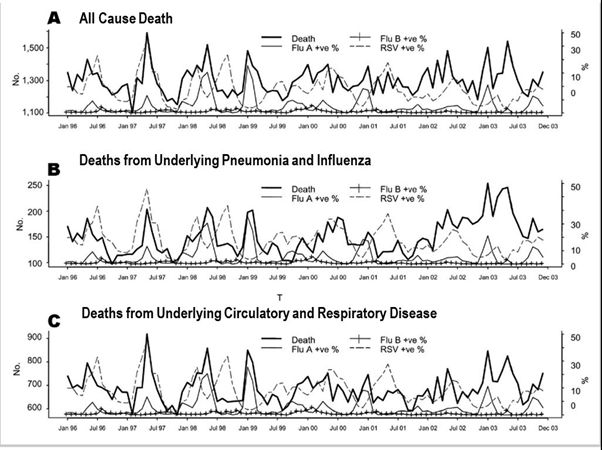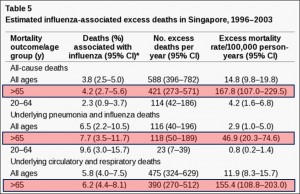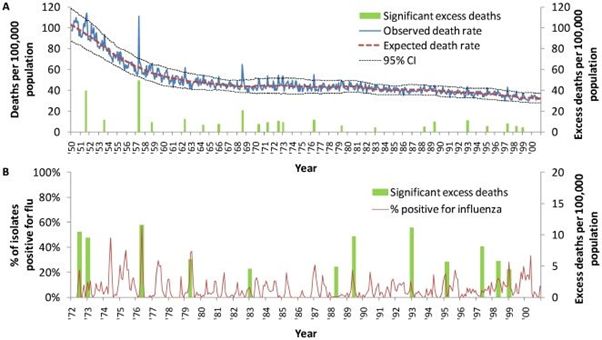We have neglected influenza. Personally, there isn’t a robust influenza vaccination programme in Singapore, and many refuse to accept influenza as a life-threatening illness. This blog will show the threat of influenza, and how it kills innocent Singaporeans when we are most vulnerable!
Many individuals accept influenza just as an inconvenience in life. But little are aware that influenza kills the elderly, those with pre-existing lung disease, diabetes mellitus and the immunocompromised. These are the so-called “at-risk” individuals. The striking thing is we all know of at least ONE at-risk individual. But are we protecting them? Or is the contrast true – that we are harming them? In an increasingly densely populated society, a brief, innocuous contact with an unknown elderly, may pass the potentially deadly virus to the individual. I will show two scientific papers published on influenza using Singapore data proving that influenza kills in tropical Singapore.
The first paper was published by Dr Angela Chow and colleagues in 2006. She and her team plotted the death rates and their underlying causes against the prevalence of influenza in the years studied from 1996-2003. They found a striking, predictable parallel rise in mortality and that incidence of influenza A. In their own words lifted in verbatim, “Peaks in monthly influenza A viruses corresponded very well with peaks in monthly all-cause deaths, underlying pneumonia and influenza deaths, and underlying circulatory and respiratory deaths.”

Deaths from various causes in black bold lines and influenza in regular solid lines. The parallels are striking. The activity of influenza deaths predicted all causes of deaths, including those of respiratory and circulatory causes.
Source Emerging Infectious Diseases. 2006 January;12(1):114-121.
When we stratify them by age, those at risk becomes immediately apparent. We define immediately who are the at-risk of dying – the elderly (>65)

In all-cause mortality, influenza is responsible for an extra 167.8 deaths per 100,000 person-years in Singapore.
Source Emerging Infectious Diseases. 2006 January;12(1):114-121.
In all-cause mortality, influenza is responsible for an extra 167.8 deaths per 100,000 person-years. Influenza cuts across social strata and the poor, with less access to medical care, will be more affected.
In another study by Dr Vernon Lee and colleagues published in PLoS ONE in 2009, they identified 12 periods of excess deaths from the years 1972 to 2003. All of these matched with influenza activity, with the exception of 1988. Again, using another methodology, mortality rates uncannily matched influenza activity.

The green bar above shows the periods with significant excess deaths, and these match with the peaks of influenza incidence seen with the red line in the lower graph. Source PLoS One. 2009 Dec 1;4(12):e8096.
You may call this coincidence, but I call this science to show that influenza kills in Singapore.
I am thoroughly convinced by these studies. With this data, we know who is at risk.
We can protect our elderly.
The situation begs for better immunisation and vaccination of the elderly. A more robust vaccination programme for a start!
References
1. Angela Chow, Stefan Ma, Ai Ee Ling and Suok Kai Chew. Influenza-associated Deaths in Tropical Singapore. Emerging Infectious Diseases. 2006 January; 12(1): 114–121. http://www.ncbi.nlm.nih.gov/pmc/articles/PMC3293465/pdf/05-0826.pdf
2. Vernon J. Lee, Jonathan Yap, Jimmy B. S. Ong, Kwai-Peng Chan, Raymond T. P. Lin, Siew Pang Chan, Kee Tai Goh, Yee-Sin Leo, and Mark I-Cheng Chen. Influenza excess mortality from 1950-2000 in tropical Singapore. PLoS One. 2009 Dec 1;4(12):e8096.


